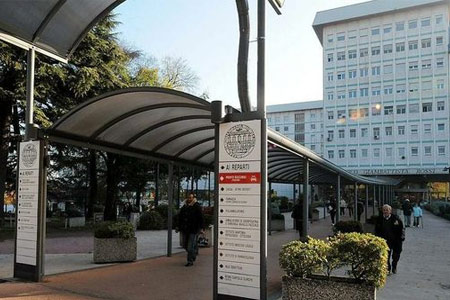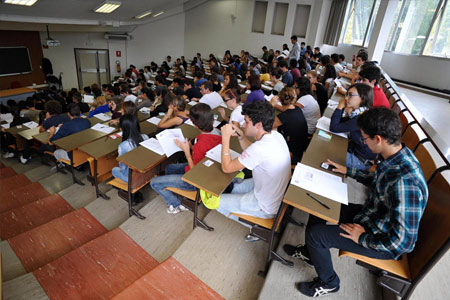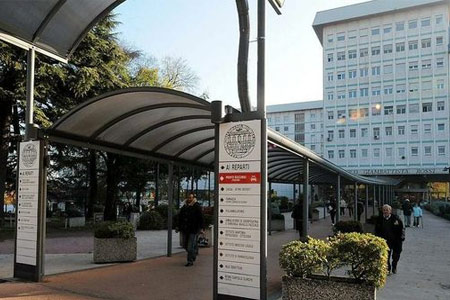- Authors:
-
Onorati, Francesco; D'Errigo, Paola; Barbanti, Marco; Rosato, Stefano; Covello, Daniel Remo; Maraschini, Alice; Ranucci, Marco; Grossi, Claudio; Santoro, Gennaro; Tamburino, Corrado; Santini, Francesco; Seccareccia, Fulvia
- Title:
-
Results differ between transaortic and open surgical aortic valve replacement in women
- Year:
-
2013
- Type of item:
-
Articolo in Rivista
- Tipologia ANVUR:
- Articolo su rivista
- Language:
-
Inglese
- Referee:
-
No
- Name of journal:
- Annals of Thoracic Surgery
- ISSN of journal:
- 0003-4975
- N° Volume:
-
96
- Number or Folder:
-
4
- Page numbers:
-
1336-1342
- Keyword:
-
35; Aged; Aged, 80 and over; Aorta; Aortic Valve Stenosis; Female; Heart Valve Prosthesis Implantation; Humans; Propensity Score; Prospective Studies; Sex Factors
- Short description of contents:
- Background. Despite the well-known impact of female sex on outcome after surgical aortic valve replacement (sAVR), few studies investigated its role after transcatheter aortic valve replacement (TAVR).Methods. After propensity-matching for age, baseline comorbidities, previous interventions, priority, frailty score, New York Heart Association class, left ventricular function and associated cardiac diseases, hospital mortality, and procedure-related morbidities of 388 women (194 TAVR versus 194 sAVR)-of 5,231 patients enrolled in 70 centers participating in this prospective multicenter national registry-were analyzed at a central management unit of the Italian National Institute of Health.Results. Although hospital mortality was comparable (4.1% TAVR versus 3.1% sAVR; p = 0.177), women undergoing sAVR showed a higher rate of transfusion (63.9% versus 37.1% TAVR; p = 0.0001); higher number of transfusions per patient (3.6 +/- 0.4 versus 2.3 +/- 0.3 TAVR; p = 0.049); a higher incidence of low cardiac output state (5.7% versus 3.6% TAVR; p = 0.017) and acute renal failure (8.8% versus 4.1% TAVR; p = 0.01); and higher mean transprosthetic gradients (15.7 +/- 12.6 mm Hg versus 11.9 +/- 10.7 mm Hg TAVR; p = 0.004). In contrast, women undergoing TAVR experienced significant postprocedural aortic regurgitation (mild, 37.6% versus 7.7% sAVR; moderate-to-severe, 7.1% versus 1.5% sAVR; p = 0.0001) and a higher rate of stroke (7.7% versus 2.5% sAVR; p = 0.037), major vascular complications (9.3% versus 0.5% sAVR; p = 0.0001), pacemaker implantation (12.4% versus 6.2% sAVR; p = 0.004), need for emergent percutaneous coronary intervention (1.0% versus 0% sAVR; p = 0.007), and longer intermediate care unit length of stay (2.5 +/- 4.4 days versus 1.4 +/- 2.6 days sAVR; p = 0.008). Perioperative myocardial infarction and lengths of intensive care unit stay and hospitalization were comparable (not significant).Conclusions. Women undergoing sAVR and TAVR experienced different periprocedural morbidities. These data strongly suggest the need to strictly individualize the indications. (c) 2013 by The Society of Thoracic Surgeons
- Product ID:
-
116321
- Handle IRIS:
-
11562/1025579
- Last Modified:
-
November 14, 2022
- Bibliographic citation:
-
Onorati, Francesco; D'Errigo, Paola; Barbanti, Marco; Rosato, Stefano; Covello, Daniel Remo; Maraschini, Alice; Ranucci, Marco; Grossi, Claudio; Santoro, Gennaro; Tamburino, Corrado; Santini, Francesco; Seccareccia, Fulvia,
Results differ between transaortic and open surgical aortic valve replacement in women
«Annals of Thoracic Surgery»
, vol.
96
, n.
4
,
2013
,
pp. 1336-1342
Consulta la scheda completa presente nel
repository istituzionale della Ricerca di Ateneo 








